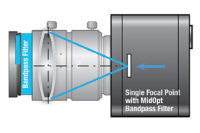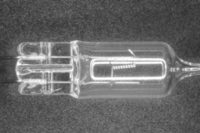Vision & Sensors - Best Practices
Using Optics to Optimize Your Machine Vision Application
Explaining the fundamentals of using optics to optimize a machine vision application.

Figure 3. Field of view and resolution example. Source: Edmund Optics

Figure 7. Relationship between spatial frequency and contrast. Source: Edmund Optics

Figure 8. Lens performance differs over its field of view. Source: Edmund Optics

Figure 9. Modular transfer function of a lens at three different locations in Figure 8. Source: Edmund Optics

Figure 14. Effect of changing iris setting on 8.5 mm fixed focal length lens. Source: Edmund Optics

Figure 15. Effect of changing iris setting on 8.5 mm fixed focal length lens. Source: Edmund Optics

Figure 13. Target used to measure depth of field. Source: Edmund Optics

Figure 21. Maintaining consistent feature size. Source: Edmund Optics

Figure 21. Maintaining consistent feature size. Source: Edmund Optics

Figure 21. Maintaining consistent feature size. Source: Edmund Optics










BASICS OF MACHINE VISION OPTICS
RESOLUTION
| In the real world, diffraction, sometimes called lens blur, reduces the contrast at high spatial frequencies, setting a lower limit on image spot size. |
Figure 3 shows a spark plug being imaged on two sensors with different levels of resolution. Each cell in the grid on the image represents one pixel. The resolution in the image on the left with a 0.5 megapixel sensor is not sufficient to distinguish characteristics such as spacing, scratches or bends in the features of interest. The image on the right with a 2.5 megapixel sensor provides the ability to discern details in the features of interest.
CONTRAST
DIFFRACTION
DEPTH OF FIELD
DISTORTION
CONCLUSION
Tech Tips
|
Looking for a reprint of this article?
From high-res PDFs to custom plaques, order your copy today!



















